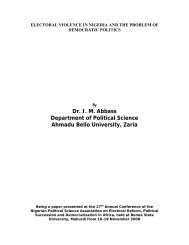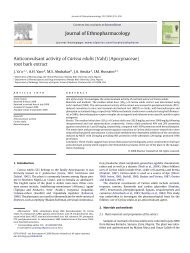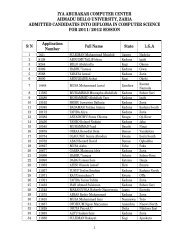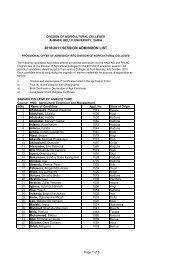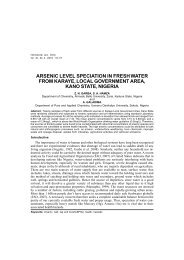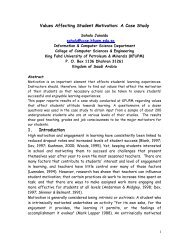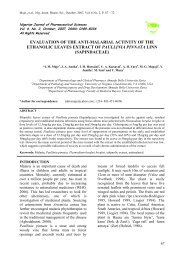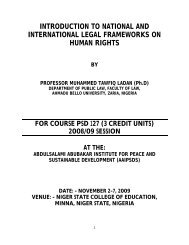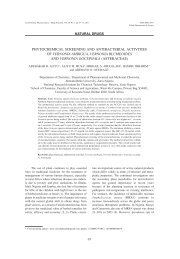Analgesic and anti-inflammatory studies of the methanol
Analgesic and anti-inflammatory studies of the methanol
Analgesic and anti-inflammatory studies of the methanol
Create successful ePaper yourself
Turn your PDF publications into a flip-book with our unique Google optimized e-Paper software.
Extraction: The powdered plant material (500 g) was<br />
extracted with <strong>methanol</strong> (2L) using soxhlets apparatus,<br />
<strong>the</strong> solvent was removed in-vacuo to yield a residue<br />
(56 g) subsequently referred to as Indig<strong>of</strong>era pulchra<br />
extract .The extract was kept in a dessicator <strong>and</strong> a<br />
fresh solution in distil water was prepared for each<br />
experiment.<br />
Chromatographic analyses <strong>of</strong> <strong>the</strong> <strong>methanol</strong> extract:<br />
The chromatographic analysis was done by thin layer<br />
chromatography (TLC) (silica gel on aluminium<br />
plates).The <strong>methanol</strong> extract was spotted on to <strong>the</strong> TLC<br />
plates <strong>and</strong> developed using three solvent system with<br />
different polarities i.e. hexane/ethylacetate<br />
(5:1),chlor<strong>of</strong>orm/<strong>methanol</strong>(19:1), <strong>and</strong> ethylacetate:<br />
chlor<strong>of</strong>orm: <strong>methanol</strong> :water(15:8:4:1). The separated<br />
components were visualized under visible <strong>and</strong> U.V.<br />
light (254 <strong>and</strong> 366 nm) <strong>and</strong> sprayed with <strong>the</strong> following<br />
reagents in order to reveal <strong>the</strong> spots <strong>of</strong> different<br />
phytochemical groups: Dragend<strong>of</strong>f’s reagent for<br />
alkaloids, 10% potassium hydroxide solution in<br />
<strong>methanol</strong> for anthraquinones <strong>and</strong> coumarins ,<br />
aluminium chloride for flavonoids <strong>and</strong> anisaldehyde<br />
/sulphuric acid for steroid, terpenes, phenanthrenes <strong>and</strong><br />
dihydrostilbene nucleus [16] .<br />
Animals: Adult Swiss albino mice <strong>of</strong> ei<strong>the</strong>r sex<br />
weighing between 19-22g <strong>and</strong> rats weighing 150-200g<br />
obtained from <strong>the</strong> animal house facility, Department <strong>of</strong><br />
Pharmacology <strong>and</strong> Therapeutics, Ahmadu Bello<br />
University, Zaria-Nigeria were used for <strong>the</strong>se <strong>studies</strong>.<br />
The animals were housed in a st<strong>and</strong>ard cage at room<br />
temperature in a 12/12 hour light <strong>and</strong> dark cycle, <strong>and</strong><br />
were supplied with food <strong>and</strong> water ad libitum. All<br />
experiments were conducted in accordance with animal<br />
use ethics as accepted internationally.<br />
Drug: Ketopr<strong>of</strong>en injection (Lek pharmaceuticals<br />
company, Slovenia) <strong>and</strong> morphine (Martindale, Essex)<br />
were used as st<strong>and</strong>ard drugs.<br />
Route <strong>of</strong> Administration: The extract <strong>and</strong> <strong>the</strong> st<strong>and</strong>ard<br />
drugs were administered to <strong>the</strong> animals intraperitoneally<br />
in all <strong>the</strong> experiments.<br />
Acute toxicity study: The study was divided into two<br />
phases. In <strong>the</strong> first phase, nine mice <strong>of</strong> ei<strong>the</strong>r sex<br />
were divided into three groups <strong>of</strong> three mice each.<br />
Group I received 10 mg/Kg extract while group II <strong>and</strong><br />
III received 100 <strong>and</strong> 1000 mg/kg extract respectively.<br />
The mice were observed for signs <strong>and</strong> symptoms <strong>of</strong><br />
toxicity <strong>and</strong> mortality for twenty four hours after<br />
treatment. In <strong>the</strong> second phase, 3 mice were divided<br />
into 3 groups <strong>of</strong> one mouse each <strong>and</strong> treated based on<br />
<strong>the</strong> result <strong>of</strong> <strong>the</strong> first phase. The first received extract<br />
Res. J. Medicine & Med. Sci., 5(1): 106-110, 2010<br />
107<br />
at a dose <strong>of</strong> 1600 mg/kg, while <strong>the</strong> second <strong>and</strong> third<br />
groups received <strong>the</strong> extract at doses <strong>of</strong> 2900 <strong>and</strong> 5000<br />
mg/Kg respectively. The mice were also observed for<br />
24 hours. The final LD 50 was calculated as <strong>the</strong> square<br />
root <strong>of</strong> <strong>the</strong> product <strong>of</strong> <strong>the</strong> lowest lethal dose <strong>and</strong> <strong>the</strong><br />
highest non-lethal dose i.e. <strong>the</strong> geometric mean <strong>of</strong><br />
consecutive doses for which 0 <strong>and</strong> 100% survival rates<br />
were recorded [17] .<br />
Acetic acid – induced abdominal constrictions in<br />
mice: Twenty five albino mice were divided into five<br />
groups <strong>of</strong> five mice each. Group I was injected with<br />
10 ml/Kg <strong>of</strong> normal saline (negative control). Group II<br />
was injected with ketopr<strong>of</strong>en 10mg/kg (positive<br />
control). Groups III, IV <strong>and</strong> V were injected with 50,<br />
100 <strong>and</strong> 200 mg/Kg <strong>of</strong> <strong>the</strong> extract respectively. Thirty<br />
minutes later, each mouse was injected with 10ml/kg<br />
<strong>of</strong> aqueous solution <strong>of</strong> acetic acid (0.6%)<br />
intraperitoneally. The number <strong>of</strong> abdominal<br />
constrictions for each mouse was counted five minutes<br />
after injection <strong>of</strong> acetic acid for a period <strong>of</strong> ten minutes<br />
with a tally counter [18] . The percentage inhibition <strong>of</strong><br />
abdominal constrictions was calculated using <strong>the</strong><br />
following formula:<br />
Inhibition (%) = Mean No. <strong>of</strong> wri<strong>the</strong>s (Control) –<br />
Mean No. <strong>of</strong> wri<strong>the</strong>s (test) x 100<br />
Mean No. <strong>of</strong> wri<strong>the</strong>s (Control)<br />
Hot plate test method: Mice were placed on a hot<br />
plate maintained at temperature <strong>of</strong> 50±0.5 0 C. The time<br />
taken for ei<strong>the</strong>r paw licking or jumping (pain reaction<br />
time) by each mouse was recorded. Mice that showed<br />
initial nociceptive response within 20 seconds were<br />
selected <strong>and</strong> used for <strong>the</strong> study. The mice were <strong>the</strong>n<br />
divided into 5 groups each containing 5 mice. Group<br />
I served as negative control <strong>and</strong> received 10ml/Kg<br />
normal saline while groups II, III <strong>and</strong> IV received <strong>the</strong><br />
extract (i.p) at doses <strong>of</strong> 50,100 <strong>and</strong> 200mg/Kg<br />
respectively <strong>and</strong> <strong>the</strong> last group received morphine<br />
(5mg/Kg). Thirty minutes later each mouse was placed<br />
on a hot plate <strong>and</strong> <strong>the</strong> pain reaction time recorded [19] .<br />
Carrageenan-induced Paw Oedema in Rats: Twenty<br />
five mice were divided into 5 groups <strong>of</strong> 5 mice each.<br />
Group I received 10ml/Kg normal saline group II<br />
received ketopr<strong>of</strong>en 10mg/Kg (Positive control), while<br />
groups III, IV <strong>and</strong> V received extract at doses <strong>of</strong> 50,<br />
100 <strong>and</strong> 200 mg/Kg respectively. Thirty minutes later,<br />
0.1ml <strong>of</strong> sterile saline suspension <strong>of</strong> 1% w/v<br />
carrageenan was injected into <strong>the</strong> subplantar surface <strong>of</strong><br />
<strong>the</strong> left hind paw. Paw size was measured using vernier<br />
caliper at time 0, 1, 2, 3, 4 <strong>and</strong> 5 hours after <strong>the</strong><br />
carrageenan administration [20] .


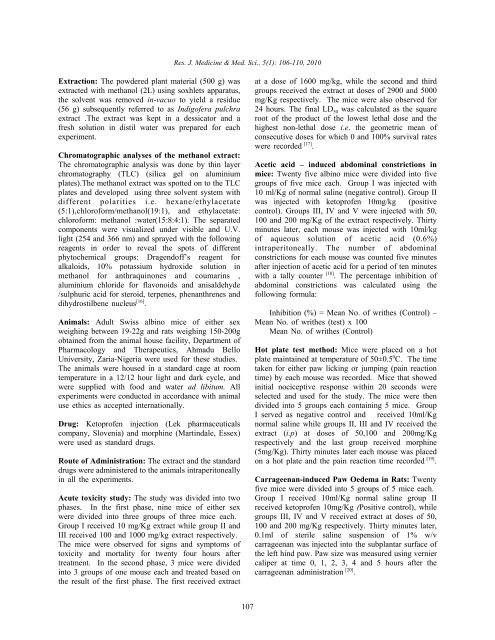
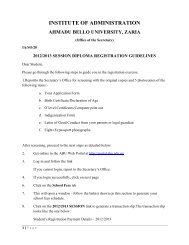
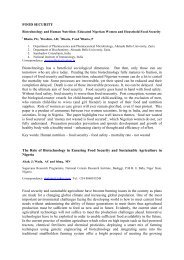

![Full Paper [PDF]](https://img.yumpu.com/49740055/1/184x260/full-paper-pdf.jpg?quality=85)
